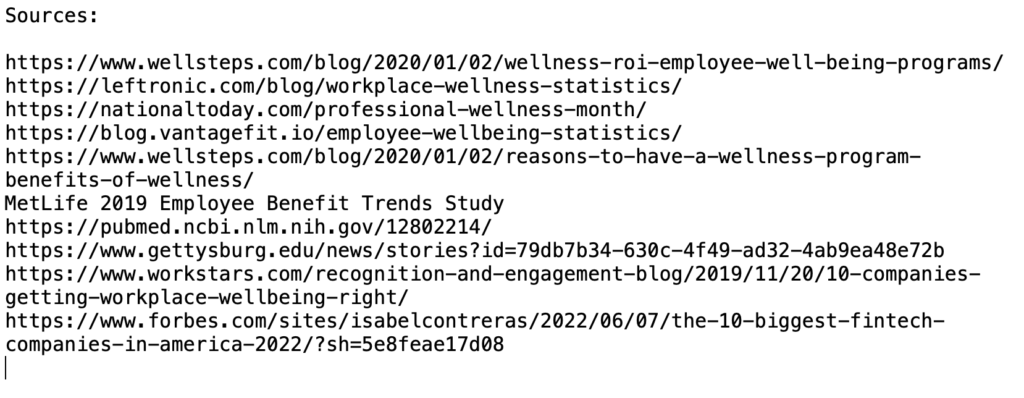
Stop the self-sabotage!
May 3, 2022
Inside LinkedIn, the biggest business network in the world.
July 14, 2022Workplace wellness programs create happy, healthy employees…but do they improve the bottom line?

The average person will spend 90,000 hours at work during the course of their life, or about one-third of their total waking hours.
With all that time spent at the office, cubicle, and desk, it’s no wonder why more employees are looking to improve their health, wellness, and lifestyle while on the clock.
And smart employers are catching on to this workplace wellness revolution, not only because of the holistic benefits to the people in their organization but because wellness programs and initiatives present a significant financial benefit.
At Microsoft, employees get a gym membership, clinic and healthcare visits, health food chefs and juice bars, and more wellness programs – all on-site and for free.
USAA, the leader in military community banking in the U.S., builds “energy zones” into their workplace where employees are encouraged to get up, move and exercise, as well as mental health resources and positive mantras printed across their headquarter’s walls.
Hilton, one of the biggest global hoteliers, launched their “Thrive@Hilton” well-being partnership back in 2017, nurturing mind, body, and spirit of all employees. Hilton offers pop-up health screenings and clinics, yoga, meditation, fitness classes, and corporate health training to permeate a culture of wellness across their organization.
Facebook offers its employees ubiquitous bicycles around their campus, and Buffer offers its workers access to therapists along with free subscriptions to health and well-being apps.
And where I work at GoodLeap, the nation’s largest sustainable solar and home improvement marketplace, we offer mindset training and weekly yoga for our employees – just one of the many reasons we’ve been named one of the Best Places to Work numerous times.
So, why are these (and many, many more) organizations investing in the health and wellness of their employees? Today we’ll look at some of those compelling reasons, as well as stats, research, and the financial accounting behind wellness at the workplace.
Here is a summary of the benefits to employers and organizations:
1. Wellness programs help recruit top talent.
2. They also vastly improve your chances of retaining current employees and keeping talent within the organization.
3. Wellness programs are proven to reduce absenteeism.
4. Just as important, they reduce presenteeism (more on that later).
5. These programs improve company goodwill and morale.
6. Studies show they foster better communication and teamwork.
7. Wellness programs significantly reduce company healthcare costs, both directly and indirectly.
8. Of course, wellness programs benefit employees by improving medical conditions, overall health, weight loss and fitness, sleep, mental health, and reducing stress!
These are the most popular wellness programs and initiatives in corporate America right now:
· On-site gyms, free gym memberships, fitness programs
· Programs to help people stop smoking
· Weight-loss initiatives
· Yoga
· Meditation
· Pet-friendly workplaces!
· Financial management, advising, and debt counseling
· Stress management and sleep enhancement programs
· On-site clinics, medical care, and routine health screenings
Facts and stats that demonstrate the need for company wellness programs
- 63% of companies with effective wellness programs report improved financial growth and sustainability.
- On average, employees who participate in holistic wellness at work take 56% fewer sick days and companies with wellness programs see a 27% decrease in sick days.
- 62% of employees who take part in company wellness programs experience lower healthcare costs (which are often passed on to employers, both directly and indirectly).
- 55% of employees would be interested in working for an employer with a wellness benefit program, and 53% of professionals say they would remain loyal to their organization if such a program was offered.
- The American Psychological Association notes that 77% of polled say that company fitness programs and gyms positively affect morale and culture.
- Promoting workplace wellness benefits individuals and the entire organization on a holistic level. For instance, they’ve been proven to reduce stress among workers, an important landmark since stress accounts for about 20% of all company direct expenses.
- That includes high turnover among employees and the associated costs, absenteeism, presenteeism, and even strikes or work stoppages. It’s estimated that the cost of stress in the workplace adds up to $300 billion annually!
What’s the ROI on workplace wellness programs?
There are plenty of studies that delve into the return on investment when companies institute wellness programs and healthcare initiatives.
One prominent research project at Harvard University aggregated all of that data, concluding that the average return on investment was 3.27 – or $3.27 saved for every $1 invested.
The same Harvard research found that every dollar invested in corporate wellness programs yielded $2.73 in a reduction in absenteeism.
Even better, an Indiana Department of Health report found that for every dollar spent on health and wellness, the company saved an average of $5.82 in costs stemming from employee absenteeism.
The bottom line $$$
Research shows that an efficient health and wellness program can reduce a company’s healthcare expenses by up to 26%, as well as a 30% reduction in employee compensation and disability management claims.
Furthermore, health and wellness programs in the workplace also lead to indirect benefits when workers are more committed and “buy in.” Those benefits include a 37% reduction in absenteeism and a 65% lower employee turnover rate.
And reductions in presenteeism (the focus and productivity of employees when at work) save organizations two to three times more than direct healthcare expenses!
So, what does this all mean for leaders and business owners?
If your company doesn’t currently offer a wellness program, it’s essential that you initiate one now – or ignore at your own detriment.
With the job market as tight as it is, workplace wellness is a major consideration for the employees and talent you’re trying to hire. Furthermore, the benefits and savings to your organization will be both tangible and significant.
Your employees will thank you – and your bottom line will reflect that!




